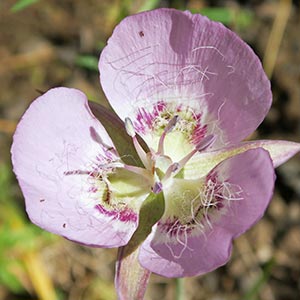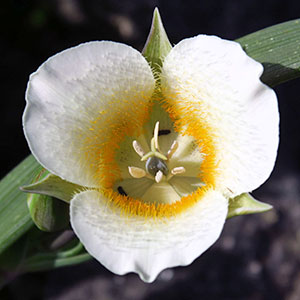Calochortus longebarbatus
Calochortus subalpinus
long-bearded mariposa lily, long-bearded sego-lily, long-hair star-tulip, longbeard mariposa lily
Cascade mariposa lily, cat's ear lily, mountain cat's ear, mountain mariposa, subalpine mariposa-lily
usually not branching, 1–3 dm, proximal internodes very short;
bulblet in axil of cauline leaf at or below ground surface.
usually not branching, straight or flexuous, often scapelike, 0.5–3 dm.
single;
basal persistent, 2–3 dm;
blade linear.
basal 1–3 dm × 2–15 mm, usually equaling or exceeding stem length;
blade flat, adaxial surface glabrous.
1–4-flowered.
subumbellate, 1–5-flowered;
bracts 2–several, lanceolate to linear, unequal, 1–5 cm, apex acuminate;
peduncle slender, becoming stouter, deflexed in fruit.
erect;
perianth open, campanulate;
sepals ovate-lanceolate, 15–20 mm, apex acuminate;
petals light pink to ± lavender, with red-purple adaxial crescent distal to gland, widely obovate-cuneate, 20–30 mm, not ciliate, with a few long hairs;
glands bordered proximally by ciliate membrane, distally by short hairs;
filaments twice length of anthers;
anther apex obtuse to abruptly short-tipped.
erect or spreading;
perianth open, campanulate;
sepals typically with purple glandular blotch near base, oblong-lanceolate, shorter than petals, adaxial surface minutely hairy, apex acute to acuminate;
petals yellowish white, sometimes lavender-tinged, frequently with narrow purple crescent distal to gland, broadly obovate, cuneate, moderately bearded nearly to apex, adaxial surface densely hairy, margins fringed, apex obtuse or acute;
glands transversely oblong, arched upward, ± deeply depressed, bordered proximally by narrow, ascending, deeply fringed membrane, distally by narrow, crenate membranes, gland surface with rather long, slender hairs toward distal portion;
anthers lanceolate, apex long-apiculate.
erect, 3-winged, ellipsoid to ± globular, 2–3 cm.
nodding, 3-winged, ellipsoid, apex usually acute.
light brown, irregular.
pale yellow.
= 20.
Calochortus longebarbatus
Calochortus subalpinus
recent collections of calochortus longebarbatus from oregon exhibit intergradation in the characters that heretofore have been thought to distinguish the following two varieties (k. l. chambers pers. comm.), and their continued recognition may prove unwarranted
Varieties 2 (2 in the flora).
(Discussion copyrighted by Flora of North America; reprinted with permission.)
1. Perianth obconic-campanulate, petals not sharply bent at gland; basal leaves not reddish at base. | var. longebarbatus |
1. Perianth broadly campanulate, petals sharply bent at gland; basal leaves reddish at base. | var. peckii |



